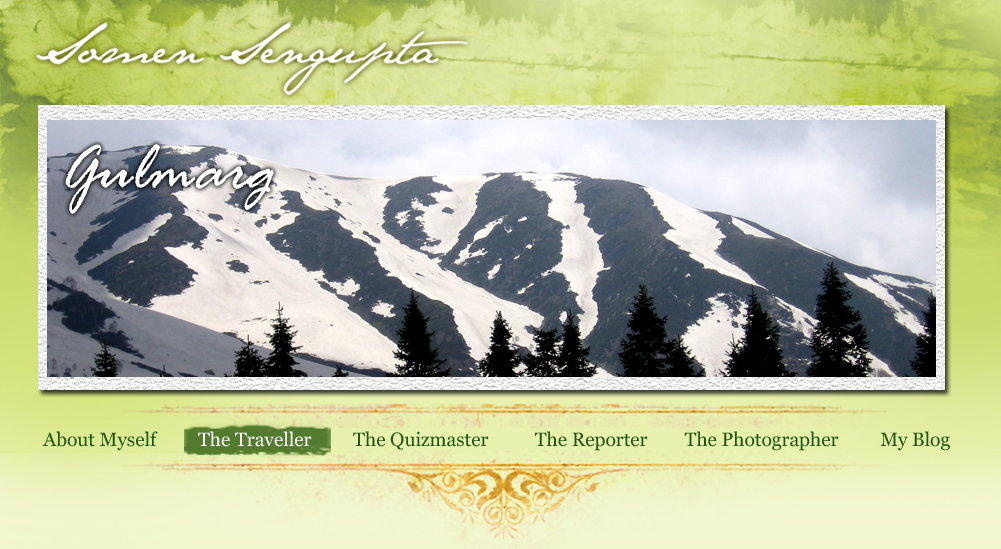| GULMARG : POSTCARD FROM GOD |
|
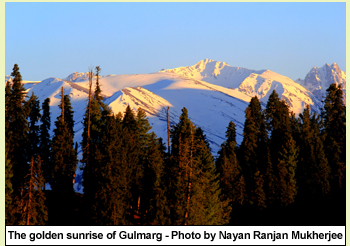
Calcutta - 1829. Bombay - 1842. Bangalore - 1876. Madras - 1877. Shillong - 1878.
No - The above is not the chronicle of East India Company’s military conquest of India in 19th century. The above is how our colonial rulers went on spreading one of their biggest sport passion golf in India. However it will not be a sheer verbosity to describe this as cultural conquest of a colony named India.
While introducing golf among Indian rich and royals British took an easy path.
Apart from big cities like Calcutta and Bombay they targeted princely states where patron and support were plenty and in this process golf arrived in Kashmir in 1880 at Srinagar, but that was not enough as soon they found a grand patch of green at an altitude of 2650 mt sur- rounded with colourful alpine flowers, water streams and breathtaking view of snowcapped Himalayan range.
The love of golf and love for nature - two typical English characteristics were per- fectly blended at the highest golf club of the world when it was shaped as Gulmarg Golf Club in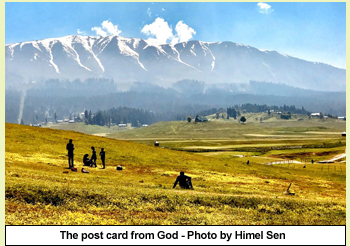 1891 by a British named Sir Neville Chamberlain who at that point never imagined that this golf course will convert this place into one the premiere tourist destination for next 100 years or so. In colonial era, apart from Europeans this club was one of the prime golfing centre of royals of Kashmirs and other places. 1891 by a British named Sir Neville Chamberlain who at that point never imagined that this golf course will convert this place into one the premiere tourist destination for next 100 years or so. In colonial era, apart from Europeans this club was one of the prime golfing centre of royals of Kashmirs and other places.
Today travelling to Gulmarg is much more than golf, but at one time it was known to the world as a place where a modern golf club is nestled at an altitude of 8690 ft overlooking a paradise of earth. It is world’s highest golf course in operation. The standard and array of amenities that this 18 hole golf course offers is amazing. Apart from a picture postcard background it houses a heritage club house with bar and restaurant. The lush green surface meets at one end from where a sharp decline of nearly 300 ft takes one to St Mary Church set up in 1902.
The small yet beautiful Victorian archi- tectural church is made of grey stone and green roof. Its significant presence on the lap of green grass of the golf course adds a magical touch to the local landscape. The church is frequented by people of all reli- gion and recently an Australian couple brought the church in news by getting themselves wedlocked there in knee deep snow and blessings of local people.
The century old history of Gulmarg is rich and its not beause of British legacy alone.
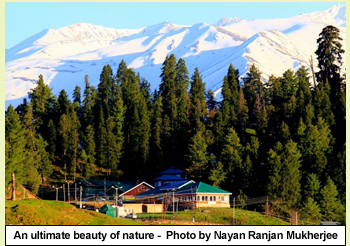 Old historical text gives support to this fact that when Kashmir was ruled by Hindu kings this place was named as Gaurimarg named after Gauri the wife of Shiva. Old historical text gives support to this fact that when Kashmir was ruled by Hindu kings this place was named as Gaurimarg named after Gauri the wife of Shiva.
The Hindu rule ended in 1339 and one Samsudhin Shah started Islamic rule in Kashmir. Soon Islam brought mass Islamisation of common people along with wanton destruction of ancient Hindu tem- ples.
In the year 1581 one Sultan Yusuf Shah of Chak dynasty came in power and changed the name of the place from Gaurimarg to Gulmarg, a pharsi word meaning meadows of flowers. He was so fond of the place that he frequently used to visit here with one of his wife named Habba Khatun. Needless to mention that the new name ‘A meadow of flowers’ had enough power to justify it as a place of roy- al romance.
Gulmarg was deeply liked by Mughal emperor Jahangir in a big way. It is believed that 21 different kinds of wild flowers were regularly collected from Gulmarg for vari- ous other Mughal gardens of Kashmir.
In winter Gulmarg turns into a kingdom of snow and the colour of the landscape changes from green to white.
Believe it or not, in 1927 Gulmarg had its first ski club that boomed with partici- pants joining from all over the world. By overcoming various logistics challenge every year during Christmas and Easter ski enthusiasts gather here to enjoy their sports. Riding of manual sledge is an age old entertainment of Gulmarg, which is now a prime tourist attraction. However the physical exhaustion of the operator seems painful in this ride. With massive snowfall and super infra of sports, Gulmarg is a natural choice for India’s national winter games for several years.
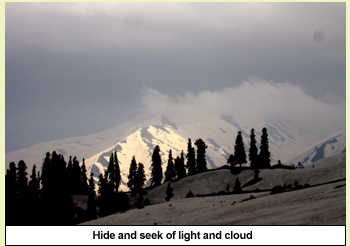 From spring to summer, with melting of snow and growing of new patch of grass, Gulmarg turns into a bright backdrop of haven where long running of Pirpanjal range of Himalaya and crystal blue sky together set the mood on fire. If one side of Gulmarg is decorated with snow clad peaks, then the other side is lit up with dark green forest of pine and fir. With that the surface gets a cover of alpine flowers, snow streams, rivulets and rocks. The astonishing colour combination of green, white and blue in same panorama sets the stage ready in such a way that in its sparkling and brightness it puts a lit up Diwali night into shame. From spring to summer, with melting of snow and growing of new patch of grass, Gulmarg turns into a bright backdrop of haven where long running of Pirpanjal range of Himalaya and crystal blue sky together set the mood on fire. If one side of Gulmarg is decorated with snow clad peaks, then the other side is lit up with dark green forest of pine and fir. With that the surface gets a cover of alpine flowers, snow streams, rivulets and rocks. The astonishing colour combination of green, white and blue in same panorama sets the stage ready in such a way that in its sparkling and brightness it puts a lit up Diwali night into shame.
The 5 km long ropeway that takes tourist from Gulmarg to Apharwat peak via Khilanmarg is also an engineering marvel. There is now a cable car service that provides breathtaking view of
Himalaya from a height. Known as Gulmarg Gandola this was designed by a French company named Pomagalski.
On a clear day, Nangaparvat one of the prime Himalayan peak, is visible from here.
The red pinnacle of a unique shaped Hindu temple at the hill top is visible from every nook and corner of Gulmarg.
Though its archaeology is tough enough to believe that it is a temple, it is one of the most sacred place for Hindus in the valley. Known as Maharani temple, it enshrines lord Shiva the most commonly worshiped God by Kashmiri Hindus. Built in 1915 by Mohini Bai Sisodia, first queen of Hari Singh the last Maharaja of Kashmir, this temple is also known as 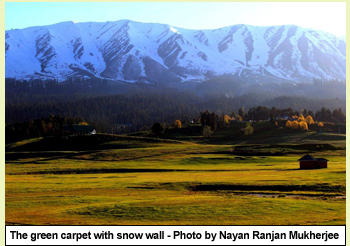 Mohineshwar Shivalaya. It is believed that the childless and unhappy queen was very deeply attached with this temple while her womaniser husband was sunk in other kinds of sinful luxury. Looking like a European country cottage, the red roofed temple is a must visit in Gulmarg. Mohineshwar Shivalaya. It is believed that the childless and unhappy queen was very deeply attached with this temple while her womaniser husband was sunk in other kinds of sinful luxury. Looking like a European country cottage, the red roofed temple is a must visit in Gulmarg.
Gulmarg is pregnant with several mem- ories of Hindi movies which were pic- tureised here. Old timers can recall the beautiful Hema Malini tantalising singing and dancing in RD Burman’s tune with evergreen Dev Anand or a young beaming Sunny Deol mounting a stallion and cross- ing the green carpet valley of Gulmarg. Several spots and iconic houses of Gulmarg are now associated with Hindi cinema and tourists are often taken there to refurbish memories of 1970s block- buster Bobby or 1980s Betaab and many more.
Motorable road ends at Gulmarg, but not the unlimited beauty of the nature. In win- ter thanks to thick layer of snow, vehicles stop 8 km before Gulmarg at a place named Tangmarg which is another win- dow of natural wonder.
Gulmarg was originally known as the path to devi Gouri and later it was named as the meadows of flowers.
The amazing truth is that both the names still shine as gems in Gulmarg's crown. It is still an abode of God whose footprint is imprinted invisibly in it's end- less beauty.
In a nutshell any part of Gulmarg seems a small postcard posted by God by his own hand.
Travel Logistics :
# Gulmarg is just 56 kms away from Srinagar.
# Cars and buses are the only medium of transportation.
# Night stay can be avoided - One can spend the wholde day there and can come back.
# JKTDC has its own hotel there - On line booking is possible - www.jktdc.co.in
# Take heavy woollens Take help of tourism police to negotiate with pony.
This article was published in The Hitavada on 5th May 2019
Click here to view the original article
|
